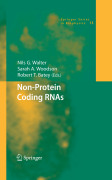
The 2006 Nobel Prize in Physiology or Medicine was awarded to the discoverersof RNA interference, highlighting just one example of a large number of recently discovered non-protein coding RNAs that are thought to outnumber protein coding genes in eukaryotes, for example, by several-fold. It appears that the complexity of organisms is correlated with the fraction of their genome that encodes non-protein coding RNAs. Essential biological processes as diverse as cell differentiation, suppression of infecting viruses and parasitic transposons, higher-level organization of eukaryotic chromosomes, and gene expression itself are found to largely be directed by non-protein coding RNAs. The biophysical study of these RNAs is an emergent field that has begun to unravel the molecular underpinnings of how RNAs fulfil their multitude of roles in sustaining cellular life Biophysical prespective on a rapidly expanding number of non-protein coding RNAs Overview on how non-protein coding RNAs work and how biophysical techniques and other probing techniques help delineate the molecular underpinnings of RNA function
- ISBN: 978-3-540-70833-9
- Editorial: Springer
- Encuadernacion: Cartoné
- Páginas: 390
- Fecha Publicación: 01/10/2008
- Nº Volúmenes: 1
- Idioma: Inglés
